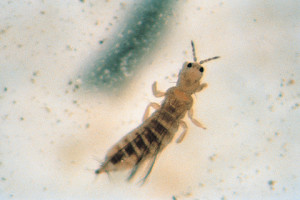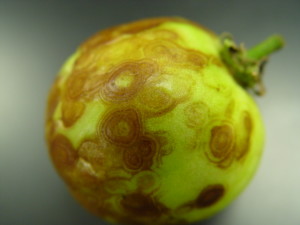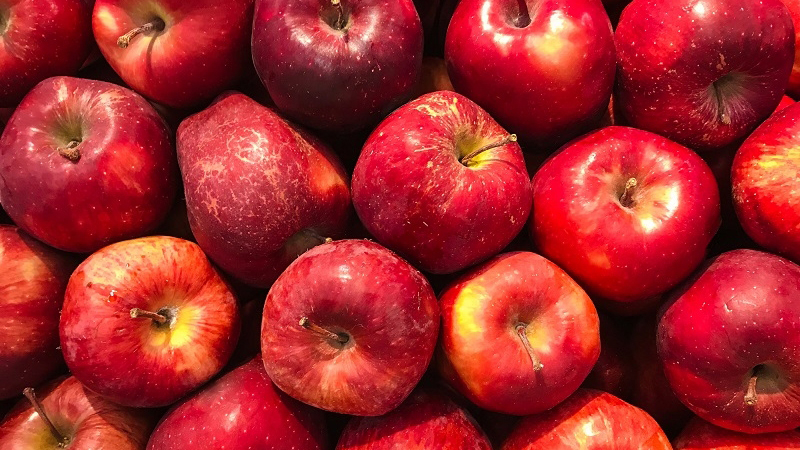Take Control Of Thrips In Your Greenhouse

Why such a foreboding title?
Thrips, one of the tiniest pests of greenhouse crops, are the carrier of one of the worst diseases on tomatoes and peppers. Tomato spotted wilt virus (TSWV), sometimes just referred to as spotted wilt, can be devastating.
Where do thrips get this virus? Spotted wilt is known to infect more than 1,000 plant species. Many of these are common weeds. As thrips feed on weeds in fields around the greenhouse, they can become infected. Once thrips pick up the virus, they have it for life. They are not good fliers, but they are easily carried by the wind. If they get into the greenhouse (or are sucked in by cooling fans), TSWV will spread to your crop as the thrips feed on plants.

Thrips are very difficult to see and often go undetected until they’re in large numbers.
Thrips are less than 1/16th of an inch (1 mm) long. They like to hide in crevices along the veins or inside flowers. If you are able to see them with a magnifier, they appear like small pencil lines on the plant, and are often not even noticed unless they move. Once you see one, keep looking — there will be more. If you could magnify them further, you would observe they have fringed wings.
Identifying TSWV
The first symptoms of TSWV on plants are numerous. Tiny spots appear on the upper leaves of tomatoes and are between a dark purple and black in color. At this point, the plants may still look healthy; however, before long the leaves will start to wilt. Once plants enter the wilting stage, they will soon die.
Fruit symptoms are yellow or green ring spots. These spots are more noticeable as the fruit ripen. Fruit can also get rather bumpy and distorted.

Plants infected early by
tomato spotted wilt virus may produce no fruit, and infected fruit will be unmarketable.
Photo(s) credit: Dr. Alan Henn, Mississippi State University Extension Service
If TSWV strikes when plants are already mature and producing, plants may survive. However, fruit set later in the life cycle may show symptoms of the virus and be unmarketable.
If TSWV hits when the plants are very young, such as the seedling stage or shortly after transplanting, it is all over. These plants are doomed, and will wilt and die. The only solution is crop removal and to start all over again.
The Tiny Vector
Note that both the singular and plural forms of the word “thrips” both end with an “s.” I joke with growers that this is because you never see just one. If you see one in the greenhouse, there must be thousands already.
Thrips are difficult to see, so their presence often goes undetected until they have already been in the greenhouse a while. This is unfortunate because if they already have spotted wilt in their system, as they feed on tomatoes or peppers, the virus easily spreads into the plants. Many times thrips have been present and plants have been infected for weeks before a grower notices a problem and seeks a diagnosis. By then, it’s probably too late.
What can you spray to kill this virus? Nothing. Viruses are systemic in plants, meaning that once infected, the virus circulates into all plant parts.
Take Control
What can you spray to eradicate thrips? This is part two of the conundrum. Yes, there are insecticides that are effective, however they do not become toxic to the insects until they are consumed. In other words, the thrips must feed on the plants first, and die later. However, because the virus enters the plant during the feeding process, infection has already begun.
The best bet with TSWV is prevention. Here are three tips:
- Control weeds around the greenhouse. Keep a buffer that is mowed or devoid of weeds so that host plants of the virus are not present near the greenhouse.
- Scout regularly for thrips. While you can see whiteflies and aphids with your eyes alone, you may have to bring a magnifier into the greenhouse now and then to check for thrips.
- If any plants exhibit TSWV symptoms (spotted upper leaves and wilting), remove them. If the plants are already producing before symptoms appear, you can greatly slow down the spread of the disease and continue to harvest from healthy plants if you remove infected ones as soon as they are discovered.
If you think you might have TSWV in your greenhouse, contact your local Extension service. Test kits are available that an agent or pathologist can use to quickly determine if thrips are a problem.










